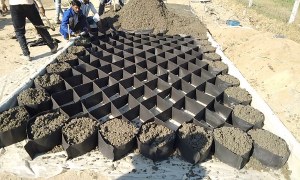🕑 Reading time: 1 minute
Contents:
Types of Precast Concrete Frames for Buildings and Structures
Precast concrete frames are constructed before actual construction starts and is transported to site for erection. There are various types of precast concrete frames such as skeletal frame, H frame and portal frame. Details, methods of design and uses of precast concrete frames are discussed in this article. Consider the following in-situ frame and its bending moment diagrams. It can be seen from the diagrams above that the joints in the precast frame are made at positions of minimum bending moment.
It can be seen from the diagrams above that the joints in the precast frame are made at positions of minimum bending moment.
Skeletal Frame:
The correct position for the skeletal frame joint is shown below. However for the ease of precasting, the skeletal frame joint is formed near the beam-column connection as shown below.
However for the ease of precasting, the skeletal frame joint is formed near the beam-column connection as shown below.
 The bending moment diagrams of the precast concrete skeletal frame will vary from those of the in-situ frame as the joints are normally taken as being pinned, though moment joints may be possible. Under vertical loading, greater sagging moments are generated in the beam. The column moment is much smaller and typically generated in the column itself.
The bending moment diagrams of the precast concrete skeletal frame will vary from those of the in-situ frame as the joints are normally taken as being pinned, though moment joints may be possible. Under vertical loading, greater sagging moments are generated in the beam. The column moment is much smaller and typically generated in the column itself.
 Under lateral loading the column moments have increased to allow for the fact that they can no longer be distributed into the beams.
The skeletal frame is most widely used in the UK. Common uses are for medium to high-rise commercial buildings, offices and schools.
Are the frame can be erected as a series of individual components, it offers a degree of flexibility in design, ease of manufacture and ease in transportation.
However, as the skeletal frame is not normally designed as fixed it cannot generate frame moment, so bracing is required. The skeletal frame does not therefore have the same degree of design flexibility as a structure with fixed joints.
Under lateral loading the column moments have increased to allow for the fact that they can no longer be distributed into the beams.
The skeletal frame is most widely used in the UK. Common uses are for medium to high-rise commercial buildings, offices and schools.
Are the frame can be erected as a series of individual components, it offers a degree of flexibility in design, ease of manufacture and ease in transportation.
However, as the skeletal frame is not normally designed as fixed it cannot generate frame moment, so bracing is required. The skeletal frame does not therefore have the same degree of design flexibility as a structure with fixed joints.

H Frame:
The bending moments of the H frame are similar to those of the in-situ frame but require the provision of essentially pinned joints at the intersection of the frame unit. H frames tend to be used on the external frame rather than the internal frame, to provide perimeter bracing. An advantage of the H frame is that it enables components to be designed to act together, resulting in shallower structural depth. Lateral forces can be carried on the frame itself allowing wind loads to be transmitted into the frame and joints. Drawbacks of the H frame mainly concern the size of the frame elements, which can lead to difficulties with transportation and manufacture. Tolerance may also have to be smaller to permit joints to be assembled very accurately.
Portal Frame:
The portal frame is similar to the H frame in that the bending moments approximate to those of the rigid, in-situ frame. There are essentially two types of portal frame- the flat portal which is less common, and the pitched portal. Both are mainly used for the industrial warehouses, being relatively cheap and easy to design and build. Moment joints at the beam-column connection and certain other features may require special attention. The portal frame is limited predominantly to tall single-storey work. The following table shows the connection, uses , advantages and disadvantages of these types of frames.
The following table shows the connection, uses , advantages and disadvantages of these types of frames.
| Connection position | Uses | Advantages | Disadvantages | |
| Skeletal frame | Beam column connection | Commercial buildings | Relatively flexible, easy to manufacture and transport | Lacks the flexibility of a fixed structure. |
| H Frame | Minimum column moment | Perimeter bracing | Shallow structural depth | Size can cause problems with manufacture and transportation |
| Portal Frame | Column connection | Industrial warehouses | Large storage area | Limited to single storey work |


